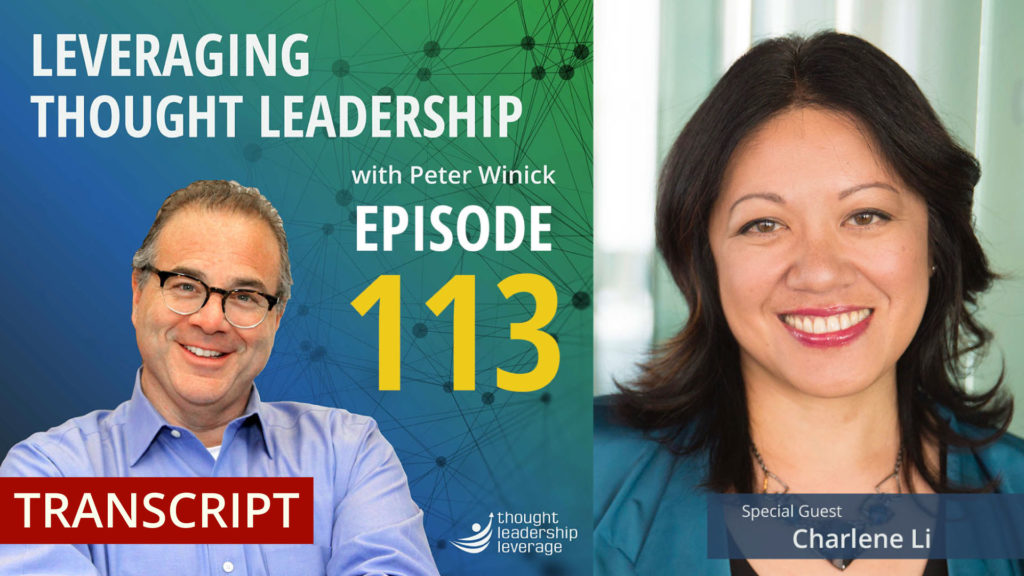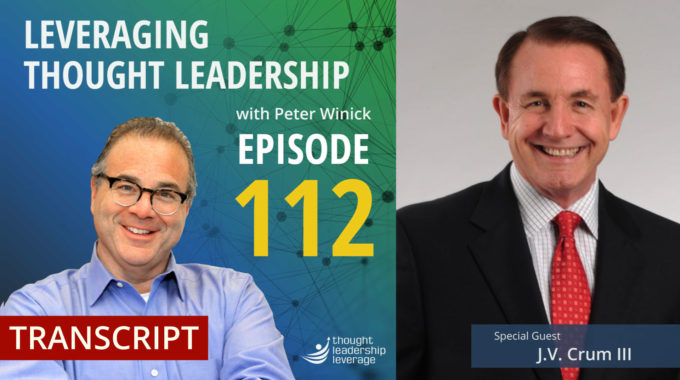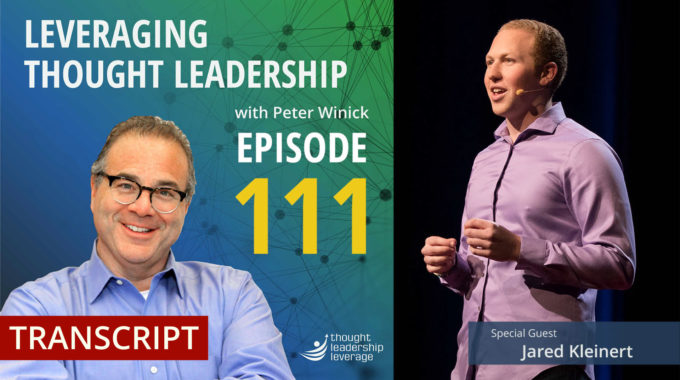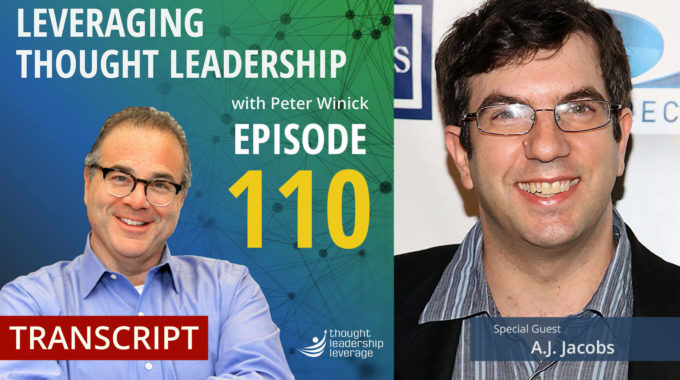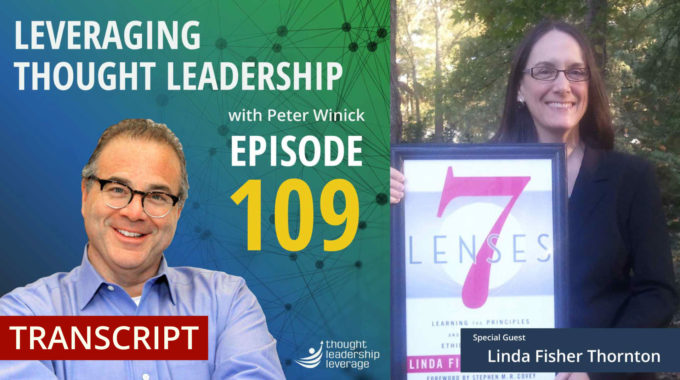Channeling Your Energy to Create Your Best Content Marketing Strategy An interview with J.V. Crum…
Thought Leadership Marketing and Social Media | Charlene Li
Helping Your Thought Leadership Marketing Find Range, Reach, and Results.
An interview with Charlene Li about thought leadership marketing, thought leadership publishing, and how to use social media to your best advantage.
We interviewed Charlene Li, founder of Altimeter Group and author of five books including the New York Times bestseller, Open Leadership. She’s here to talk to us about using social media to develop your thought leadership marketing, and how traditional publishing methods might not be the right fit!
Three Key Takeaways from the Interview:
- How to use a design thinking approach to your thought leadership and social media.
- Looking for a “strategic fit” for your thought leadership, and how to find your best avenue to success.
- Why you should have a really good email newsletter list – and be consistent about posting on it!
Transcript:
Peter And welcome, welcome, welcome, this is Peter Winick, the founder and CEO of Thought Leadership Leverage, and you’re joining us on the podcast today, which is Leveraging Thought Leadership. My guest today is Charlene Li. Charlene, for the past two decades has been helping people see the future, which is sort of an interesting thing to have as a career. She’s the author of five books, including the New York Times bestseller Open Leadership, and she’s the coauthor of the critically acclaimed book Groundswell. She was the founder of Altimeter Group and an analyst firm that was acquired in 2005 by Profit. She’s a graduate of Harvard College and Harvard Business School. I’m thrilled to have you. I’m a little I’m a little fanning out today because I’ve read all your work and have been a fan for a long time. So I’ll try to not get all giddy on you. But thank you for joining us today.
Charlene Li Thank you for having me.
Peter Great. So let’s talk about sort of your journey. You’re in lots of different things, right? You’ve got the speaking side. You’ve got the research side. You’ve got the consulting side. You’ve had an exit of your business, successful authorship. How have you sort of unpack all these things? How have you played these things out in such a way that have achieved such great outcomes like they have?
Charlene Li I feel I still feel like I I’m still trying to achieve it. I think got it that way. I think more than anything else, I’ve always been very curious about what the future brings and in particular, how did people deal with that and make the most of it. I like to say that I’ve lived for what I call the aha moment, which is why the search is so interesting. Say, because I I’m kind of curious on what the answer is.
Peter So part of this is your own sort of curiosity and your own sort of being a lifelong learner. So once you decided to sort of go down this path, how do you choose sort of when to publish and how to connect speaking and consulting? Because where I where I was going a bit earlier is you’ve achieved some amazing success and things that people hope to achieve as they sort of dove into this world of thought leadership. So what are the some of the things that you’ve learned from what you’ve done along the way that others could benefit from?
Charlene Li I think from the research side of an upturn point of view is when do you publish, you publish and you think somebody could really benefit from it. And I’ve never published anything to get followers or to build my very people. And it’s always been to be able to help other people. So that’s what’s always guide my publishing. So I sometimes publish things when I’m really not comfortable with it yet, but I feel like I have to get it out there. And then speaking, it comes with the publishing that people want to hear more about it. They want to have it applied to their situations.
Peter Got it. So how does that relationship work where someone, you know, region article or picks up an HP blog or picks up your book and says, wow, this this trillion is really fascinating. We should bring her in for our conference? Or is it that they’re seeing you speaking and then it leads to other opportunities on the consulting side and then books? Or how are those two connected from a business perspective?
Charlene Li It’s actually a very connected. When I write my research, I start with it. I think design thinking approach, which I say is to focus really specifically on the problem I’m trying to address. What’s the problem? You spend a huge amount of time on that. So when somebody reads it with that problem, then they call me like, Hey, you seem to know something about my problem. I feel like you’re standing over my shoulder watching me work. Can we talk?
Peter So that’s interesting. And when you say that’s my problem, let’s talk about that for a little bit, because some folks come into this space and say, listen, I’m smart. I’m curious. I’m an academic, whatever the cases. But I’ve got to pick something that is a problem that needs to be solved. So how do you sort of balance that, like, you know, your discipline around the research and then you go, wow, that’s a that’s a problem that people actually pay good money to have solved. Do you untangle that web?
Charlene Li Well, I always in my interviews ask people, so what’s on your mind? What would you like to see me research? What do you not have the answer for? That’s where I begin and often end all of my conversations. What else would you like to know? So a colleague of mine said, I always do the AVR always be research. OK, I love that. So conflict me asking. And then from there I start passing apart and really taking that. What is the real question? Is that really the question? It’s something deeper than that.
Peter So interesting. So people will tell you what they need. But then just because a random individual makes a comment doesn’t mean that you’re going to then spend 18 months of your life writing a book on that. So how do you sort of sort of dove in and like what you said about diving in deeper, but how do you sort of take something that at first is an aha moment to you, then either decide to go deeper or to sort of toss it away? That might not be enough.
Charlene Li Well, I talk in my next book, which is called The Disruption Mindset was coming out in June. And disruption has been around for as a buzz word for 20 years the entire time from my career as an analyst. And people would ask me, so how do I actually create disruption? How do I actually create meaningful, deep, transformational, disruptive change and growth? Well, OK. And I realize I didn’t know the answer to that. That’s a good question! Let me go look at it. So I’ve been teasing it apart. What is it mean to be really disruptive and how do you do it? Because there is that philosophy out there that you need to be disruptive. But, hey, if you’re a big and covert company, you’re toast, right? You can’t be this right. And I find that to be not true. So what is it that these companies who are able to disrupt themselves, what do they do?
Peter So let’s push on that. So now that gives you the validation. You say there’s a book here. Because there’s a real hero here. Right. In terms of how does one disrupt if we all want to be more disruptive than the next logical question is, how might I go about that? And that’s sort of the promise of the book. And I assume that would naturally lend itself to consulting relationship after that where organizations say, hey, can you help me develop these disruptive capabilities inside of my organization? Is it? Is that a fair statement?
Charlene Li Yes, very much so. I write the books to be helpful to people. And if they can go off and do this on their own, all the power to them, if they want me to come and help them take that first step with a workshop or speaking, I can do that if they want deeper hand-holding that my parent company profit can go do that. Interesting. OK. Again. What? That’s how I kind of pass it out. I don’t have to do all of that. I can’t do all of that.
Peter Sure. So I love that. So let’s go backwards a little bit, because I am fortunate enough to be working with lots and lots of consulting firms from around the globe and all sort of founded by thought leaders. People are writing books and have a perspective, etc.. Given that you’ve founded a successful consulting firm and have an exit, had an exit there and then have stayed on with the acquirer, which is profit, which is a great company. Could you talk a little bit about that? Like what are the things that you might do differently if you were to start another consulting company or advising someone on how to do well, develop another consulting company with potentially an exit amount?
Charlene Li Yeah, again, I think the key thing to always do is to never start a company with an exit because you’re doing that, you’re doing it for the wrong reason. When I started, ultimately again, I saw an opportunity there to do things very differently as an analyst firm. And even when I started, the process of being acquired by profit didn’t start out that way. I was in a search for a strategic partner and an investment to grow the company. And I had as an option in a back pocket the opportunity be acquired, but had to be the right circumstances. So when profit came along, like, well, they said, we won’t we don’t want to do an investment. We just don’t do that. But we’d be interested in acquiring you. Oh, well, that’s interesting. Pull out the back pocket. I said, well, what’s up in it? Literally, I haven’t written down. So you don’t get swayed. What are the circumstances? There were two things on there. There had to be a strategic fit, right. And there had to be a small connection to culture. And that’s why I have stayed on it. Profit is because the culture is so strong. It’s so in line with the things that I believe in. So I love that a lot of people like want to get out of there. I’m like, I’m putting out.
Peter So let me, one, is sort of correct something I said my intent wasn’t build it with the intent to sell it, build it with having that as an option to have potentially an exit. Because I agree with you. If you just build it for the sake of I’m going to build this and do this for three years and have an exit. So let me sort of reframe the question, what are the things now that you’ve been through an exit that you may have done differently or that you did that worked well, that when you’re starting a company, it’s good to be thinking about, even though it might not be on the rear end.
Charlene Li But I think it’s two things. I think having a brand, a brand is important because in many ways what profit was acquiring was our brand in the digital space. And they. Wanted to be more famous and have a better brand in the digital space. I have an opening. So really investing in brand in the very beginning was really important.
Peter So give me some examples of that, because I agree a thousand percent. But what’s an example of investment? I mean, writing a book could be an example of an investment in the brand and investing in thought leadership. But what are the other things that you do to make smart investments into the brand as a thought leader?
Charlene Li It’s so tempting to make it about you. So which puts the brand. You said you the thought leader or is that an umbrella brand? And the thing that we did at Altimeter was each partner agreed that the personal brand and the company brand lived in harmony with each other.
Peter Not easy, not easy to achieve.
Charlene Li Not easy. And so you need a special kind of person who understands what branding means. And for some people, the ultimate brand was a lot of people know ultimately and don’t know me. Sure, other people know me, but don’t know ultimate. So why not promote? Can you actually promote and lift up to brands at the same time? That was counterintuitive and it worked brilliantly.
Peter Great. And I agree with you. I think when you. It’s a balancing act. There is a time where it may be wise for you, the individual, to be the brand. If it’s more personality based, if you’re more on the keynote side. But ultimately, you know, one of the things I always tell my clients is, listen. The objective is ultimately to make you irrelevant or obsolete. And you can’t do that if all everyone is buying is the name on the door, which is yours. So that that’s all.
Charlene Li So yeah, if you want to be acquired, you can’t be with many of the name of yourself. Right.
Peter Exactly. So that’s good insight there. Let’s talk about the other. So now the other things that you said in terms of what went well for you at profit is the strategic fit and the cultural fit. So let’s talk about each of those. So culturally, you can have a great strategic fit. There were things that you were probably sniffing out as the required to go. I feel comfortable here or this is gonna be a disaster. Right. So how did you how did you know it was a cultural fit?
Charlene Li I walked in and sat down and everything. And the discussions constantly were, how do we make this work? How did you make this work? And one of their values is being just human. Just this constant, this sense of vulnerability, humility, not knowing the answers and just being all the things that being human is wonderful for. And that just really spoke to me.
Peter But let me pause for a second, if I could. So there are plenty of consulting firms where the culture is a little bit of hubris, a little bit of arrogance, a little bit of smartest people in the room, and not that that’s a good thing or a bad thing. We could debate and I think we know where we’d land there. But that’s just the culture, right? So if you think about some of the big, big firms, we don’t get to name them. That’s just their culture. And, you know, the little firms sort of being gobbled by the bigger one, you’re not going to change that. So I think it’s really, really wise how you sort of did a culture detection and said this just feels right. This feels human. We have the same value.
Charlene Li Right. And the reason why is because if you’re aligning your culture and your values, you can work out the strategy. Right. You can change your strategy. Very, very difficult to change your culture.
Peter Totally. So interesting. So that that was the indication as a cultural fit. And obviously you still here and happy. So you made the right choice. How do you know, you know, strategically, what’s a strategic fit for you as the acquired versus the acquirer? Those two things have to be equal, right. So how do you know that? How do you get a sense of that?
Charlene Li We’ve really sat down and had really deep discussions about why are you interested in this? Why would you be interested in you? Where are the synergies? I mean, the typical ideas, but also tapping into how have they worked with other thought leaders, how they work with other authors. And here is a really big tip. Almost every single person on the executive committee had written a book.
Peter So you weren’t the first sort of experiment. They’ve done this before.
Charlene Li Far from it. Far from it. They all realized what it was. Their executive chairman, Prophet’s executive, David Aaker, who’s a professor and literally, the father of brands. Right. And it is so awesome to sit down in the office and just brainstorm stuff with David. My I got the same guy. What do you got going? It is like talk of talk with each other over the water cooler, literally about our big ideas and books. I mean, how cool and fun.
Peter Well, I was to say it. So something about the values where you have an executive team where each and every one has their own sort of flavor of thought leadership that they’ve invested into or not only do they know what it takes to do that, but they also I mean, what great conversations must happen around the lunchroom like that sounds also very interesting. That’s how you knew. How do you think they knew that you were the right fit for them both strategically and culturally?
Charlene Li Again, I think the culture fit was a key part of all those conversations. They looked at our values and look at the way that we talked with each other and how we frankly, I can go through a negotiation gives you a lot of insights into how it’s going to work because there’s nothing more contentious than going over being bought.
Peter Right.
Charlene Li The other part was a strategy. I actually went in profit, it’s done a good job of other acquisitions. I asked to be connected with all the other CEOs of the companies I had acquired. Got it. And I asked them, So how did that go? What worked but didn’t work? What should I be looking out for? So of course, any sort of integration is hard. I mean, that first year was really miserable. So in so many ways and I don’t sugarcoat it, it’s just hard. This is hard to integrate a company into another one. But the thing that kept us going were these two therapists teaching that will leave. That was there. And the culture is kind of smooth things over.
Peter That’s fantastic. Well, that’s awesome insight. Let’s talk a little bit now around authorship. So you have a new book coming out. You talked about, you know, it’s time to write when, you know, you’ve got something to answer. What are things that you’ve noticed that are different in the publishing world today than maybe when you wrote your first book? And how are you adopting that?
Charlene Li So, yeah, I wrote my first book and published it in 2008 doing this one just eleven years later. My first book had a significant royalty upfront. It was put to auction. I had an agent, I had lawyers. This one I’m self-publishing.
Peter Right. So it’s so fascinating. Right. So let me drill on that a little bit because I think way back in the stone ages of 2008, right. Where we I think we all had AOL accounts or whatever we had then. If you said self publishing, that was sort of code for oh, I’m so sorry you didn’t get a big New York publisher to accept. You write it. Sort of. Welcome to Loserville. That’s not the case today. So tell me how you went about making this decision.
Charlene Li Well, I think that the opposite is true. If you so choose, you self-published, you can’t get one, but you also self-publish. If you have such a strong base, you pretty confident you can drive the sales without the help of a publisher. And over. This is, I think, my fifth or sixth book now, depending on how you count it. But my fourth publisher relationship and my other publishers have been fantastic. Right. But this time I wanted to do things with the book that they couldn’t do. I want to be able to customize the book whenever and however I want. So creative freedom, creative freedom. Total creative freedom. And frankly, as any author knows, you’re doing most of the heavy lifting for marketing anyways. So in the last part is the economics. I really got sick of buying and had, you know, twice what it cost to actually print it. And because I do a lot of speaking, I want to include the book in my speak. And I just didn’t have the flexibility to do the deals I wanted to.
Peter So I love it. So instead of you being relegated to a royalty stream of a book or to a book or whatever, the cases, you know, have the lion’s share of it. You actually cost of paper and ink, blah, blah, blah. But now it’s an 80 percent margin product. And once you come to the realization that you’re the primary sales force of that product, not the publisher, there’s a math piece of this that people often discount.
Charlene Li Way to go. Wait a minute. This doesn’t make any sense. So. And also, if I’m he was a the book as a promotional vehicle. It’s a pretty expensive vehicle. If I had to buy the book back myself versus being a it myself. So there’s a lot of different reasons why I decided to do self-publishing. Why are they, Alice? Because I’ve done it. I’ve done it multiple times now. I’ve seen how it works. If you’re a serious business author trying to build your platform, I would highly recommend first time authors to get a publisher. This is too much too overwhelming, too. Right. Right, right. It’s too much. Writing a book is hard enough to self-publish a book on top of that, to drive all the marketing and the planning and everything else. That’s really difficult to do.
Peter But if you think about it a little bit of a later stage, you’re second or third or fourth. You’ve got a little bit more infrastructure. You’ve built the platform. You’ve got a database. Right. So, yes, you have to focus on creating a good book from a content perspective. But there are some assets that you have developed as an entity that can be deployed in service of that after the first one.
Charlene Li Exactly. We think of it as having a platform. Once you have a platform, you have your list. You have your follower becomes so much easier.
Peter Got it. Okay. So let’s assume now that we’re talking to you 10 or 15 years ago, what advice would you give you as you were just starting into this world of thought leadership? Because there’s definitely people out there that fits that model.
Charlene Li It’s all about your list. The best advice I ever got, which I didn’t follow, was to have a really good email newsletter list and be really consistent about posting on it. So it’s the shorthand is it’s all about the less than who do you have a direct relationship with. I decided not to do the email newsletter because it was getting very confusing between my personal email newsletter and my company newsletter. So I think folks to the company. So I have a great list for altimeter. I don’t have a great list for myself, but I do have a huge social media platform. So that’s what I invested in. So think about your platform. Think of list and invest in it.
Peter And when you say when you say invest in it, I’m going to translate that and correct me if I’m wrong. You have an obligation, right? So you get hardly anybody sign up once. But you have to nurture that community. You have an obligation to feed them great content and be of service to them and give them insights. And just cause I signed up once doesn’t mean I wouldn’t be loyal to you for next five or 10 years if you haven’t sort of provided me with value and interesting content.
Charlene Li Yeah, exactly. And I think that the best thing that you can see from people who are really good influencers is a really consistent about creating meaningful content. And the reason they do that isn’t just a content out there. They’re thinking actively about what does my audience need? What kind of relationship do I want to build with them? Right. And I’ll give you an example. One of the things that people do after I come I do a speech is they come up to me, go, hey, that was a great speech or a trip. It’s I really enjoyed your book. And I go, thank you very much. What was your takeaway? But that follow up question is so essential because it says, I’m interested in you. I’m interested in how you are, because I learn from what you learned from. And yeah. By asking that question, I think I want a relationship.
Peter And this has been really, really wonderful. I wanted to just take a minute. Thank you, Charlene, for all that you’ve shared with us today. Your journey, the way that you go about creating content, the way they go about thinking about the business. Sharing with us the acquisition that you went through and everything else you’ve shared. It’s just really, really been chock full of great information. I appreciate your work and I appreciate your time with us today. Thank you so much.
Charlene Li Thank you for having me.
With so many modalities to pick from, you might also find yourself overwhelmed with ideas. Our COO Bill Sherman talks about why sometimes you need to close the Idea Factory.
